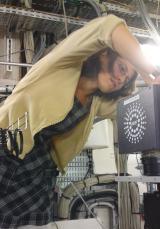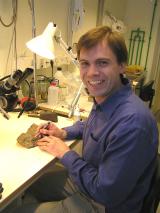- Home
- News
- General News
- Jaw dropping: scientists...
Jaw dropping: scientists reveal how vertebrates came to have a face
12-02-2014
A team of French and Swedish researchers have presented new fossil evidence for the origin of one of the most important and emotionally significant parts of our anatomy: the face. Using micron resolution X-ray imaging, they show how a series of fossils, with a 410 million year old armoured fish called Romundina at its centre, documents the step-by-step assembly of the face during the evolutionary transition from jawless to jawed vertebrates. The research is published in Nature on 12 February 2014.
Vertebrates, or backboned animals, come in two basic models: jawless and jawed. Today, the only jawless vertebrates are lampreys and hagfishes, whereas jawed vertebrates number more than fifty thousand species, including ourselves. It is known that jawed vertebrates evolved from jawless ones, a dramatic anatomical transformation that effectively turned the face inside out.
In embryos of jawless vertebrates, blocks of tissue grow forward on either side of the brain, meeting in the midline at the front to create a big upper lip surrounding a single midline ”nostril” that lies just in front of the eyes. In jawed vertebrates, this same tissue grows forward in the midline under the brain, pushing between the left and right nasal sacs which open separately to the outside. This is why our face has two nostrils rather than a single big hole in the middle. The front part of the brain is also much longer in jawed vertebrates, with the result that our nose is positioned at the front of the face rather than far back between our eyes.
Until now, very little has been known about the intermediate steps of this strange transformation. The scientists studied the skull of Romundina, an early armoured fish with jaws, or placoderm, from arctic Canada. The skull is part of a collection of the French National Natural History Museum in Paris.
|
|
Daniel Goujet from the French National Natural History Museum (MNHN) during the trip to arctic Canada. Credit: D. Goujet/MNHN |
Romundina has separate left and right nostrils, but they sit far back, behind an upper lip like that of a jawless vertebrate. "This skull is a mix of primitive and modern features, making it an invaluable intermediate fossil between jawless and jawed vertebrates", says Vincent Dupret of Uppsala University, one of two lead authors of the study.
 |
|
 |
|
The three scientists from the University of Uppsala. From left to right: Sophie Sanchez working inside the experimental hutch on the ESRF's ID19 beamline; Vincent Dupret and Per Ahlberg. Credit: V. Dupret & Uppsala University |
||
By imaging the internal structure of the skull using high-energy X-rays at the European Synchrotron (ESRF) in Grenoble, France, the authors show that the skull housed a brain with a short front end, very similar to that of a jawless vertebrate.
"In effect, Romundina has the construction of a jawed vertebrate but the proportions of a jawless one", says Per Ahlberg, of Uppsala University and the other lead author of the study. “This shows us that the organization of the major tissue blocks was the first thing to change, and that the shape of the head caught up afterwards", he adds.
|
|
Paul Tafforeau from the ESRF during the experiments carried out on ID19 beamline. Credit: V. Dupret/Uppsala University |
By placing Romundina in a sequence of other fossil fishes, some more primitive and some more advanced, the authors were able to map out all the main steps of the transition.
"Without the intense X-rays produced at the ESRF, we would not have been able to create a virtual representation of the internal structures of the skull" said Sophie Sanchez from The European Synchrotron (ESRF) in Grenoble.
References
A primitive placoderm sheds light on the origin of the jawed vertebrate face - Vincent Dupret, Sophie Sanchez, Daniel Goujet, Paul Tafforeau, Per E. Ahlberg, Nature, 2014.
Top image: The skull of small fossil fish Romundina, 415 million years old, was scanned at the ESRF and digitally reconstructed in three dimensions. Credit: Uppsala University/V. Dupret




